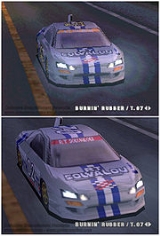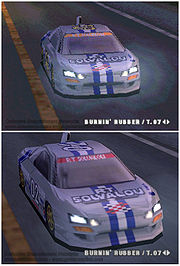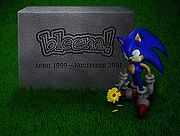
Bleemcast!
Encyclopedia

Emulator
In computing, an emulator is hardware or software or both that duplicates the functions of a first computer system in a different second computer system, so that the behavior of the second system closely resembles the behavior of the first system...
by Bleem!
Bleem!
Bleem! was a commercial PlayStation emulator released by the Bleem Company in 1999 for IBM-compatible PCs and Dreamcast...
for Dreamcast that allows one to load and play PlayStation discs on the Dreamcast. It is compatible with most Dreamcast controllers and steering wheels, and enhances the PS1 game. It was originally created by using the MIL-CD
Mil-CD
MIL-CD is a compact disc format created by the video game company Sega in 1999.The main purpose of MIL-CD was to add multimedia functions to music CDs, for use in Sega's Dreamcast games console...
security hole in the Dreamcast BIOS
BIOS
In IBM PC compatible computers, the basic input/output system , also known as the System BIOS or ROM BIOS , is a de facto standard defining a firmware interface....
.
The early years
Originally, Bleem! was planning to have the disc able to run any PlayStation game on the Dreamcast, but due to technical difficulties, they made the idea of the "Bleempak", in which the software would boot only 100 specific games each. New Bleempaks would have to be purchased if one game was not available to boot in a Bleempak. Due to the Dreamcast controller's fewer buttons compared to the PlayStation, there were plans to release a Bleem! controller (somewhat similarly designed to the PlayStation controller) and a PS1-to-Dreamcast controller adapter (which would allow one to use a PlayStation controller on the Dreamcast). As technical difficulties grew further, all these ideas were scrapped, with no "Bleempak" and no hardware releases.However, they managed to release individual Bleemcast! bootdiscs for three popular games: Gran Turismo 2
Gran Turismo 2
is a driving simulator / racing game for the Sony PlayStation. Gran Turismo 2 was developed by Polyphony Digital and published by Sony Computer Entertainment in 1999. The games serves as a sequel to Gran Turismo...
, Tekken 3
Tekken 3
Tekken 3 is the third installment in the popular Tekken fighting game series. It was released for Arcades in March 1997, and for the PlayStation in mid-1998. The original Arcade version of the game was released in 2005 for the PlayStation 2 as part of Tekken 5s Arcade History mode...
, and Metal Gear Solid
Metal Gear Solid
is a videogame by Hideo Kojima. The game was developed by Konami Computer Entertainment Japan and first published by Konami in 1998 for the PlayStation video game console. It is the sequel to Kojimas early MSX2 computer games Metal Gear and Metal Gear 2: Solid Snake...
(Box Scan). As promised from the beginning, the games ran in a 640x480 resolution, as opposed to the PS1's 320x240 resolution, and featured anti-aliasing
Anti-aliasing
In digital signal processing, spatial anti-aliasing is the technique of minimizing the distortion artifacts known as aliasing when representing a high-resolution image at a lower resolution...
and bilinear filtering
Bilinear filtering
Bilinear filtering is a texture filtering method used to smooth textures when displayed larger or smaller than they actually are.Most of the time, when drawing a textured shape on the screen, the texture is not displayed exactly as it is stored, without any distortion...
. This drastically improved the games' graphics (more so than the backwards-compatible PlayStation 2
PlayStation 2
The PlayStation 2 is a sixth-generation video game console manufactured by Sony as part of the PlayStation series. Its development was announced in March 1999 and it was first released on March 4, 2000, in Japan...
), but also brought out some graphical imperfections that were originally hidden in the lower resolution.
The death of Bleem!

Sony
, commonly referred to as Sony, is a Japanese multinational conglomerate corporation headquartered in Minato, Tokyo, Japan and the world's fifth largest media conglomerate measured by revenues....
ultimately did not win any of its lawsuits against them, Bleem! had to shut down when the huge court costs became too much for the small company to handle. Bleem! shut down in 2001, the same year Sega announced that they would discontinue the Dreamcast in North America. Bleem! closed their website with only an image on their frontpage of Sonic the Hedgehog
Sonic the Hedgehog (character)
, trademarked Sonic The Hedgehog, is a video game character and the main protagonist of the Sonic video game series released by Sega, as well as in numerous spin-off comics, cartoons, and a feature film. The first game was released on June 23, 1991, to provide Sega with a mascot to rival Nintendo's...
tearfully holding a flower next to a Bleem! gravestone. The image was later altered and Sonic was removed possibly to avoid a lawsuit from Sega.
Beta leak
A beta build of Bleemcast! was eventually leakedInternet leak
An Internet leak occurs when a party's confidential information is released to the public on the Internet. Various types of information and data can be, and have been, "leaked" to the Internet, the most common being personal information, computer software and source code, and artistic works such...
. Even though it was very buggy and incomplete, it would run many PlayStation games. http://www.whipassgaming.com/genesisreviews/Bleemcast/bleemcastcompatibility.htm Also, using this beta, hackers were able to create "Bleemed" games — discs of a PlayStation title with the Bleemcast! emulator built-in. Many of these discs circulate on file sharing networks. A game compatibility list can be found here.
After the leak, the developers made a public statement regarding the beta, providing some insight to the development process. The commercial Bleemcast! release is notable as the only release on the Dreamcast that has not been pirated, as it has deep layers of copy protection schemes. All 3 bleem packs were finally cracked and made available illegally online in December 2009, 8 years after they were first introduced.

